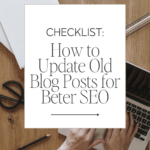
Reviving Old Blog Posts for SEO: A Checklist
Table of Contents
ToggleSharing is caring!
Reading Time: 4 minutes


Most bloggers focus on new content with no real direction in terms of maximising old content. Don't miss out on the benefits of reviving old posts.
Your regular optimisation efforts should include updating old content with the help of a local SEO agency. The fact is, new isn't always better when it comes to SEO. Updating content that already exists remains a valuable optimisation practice. What are the benefits of updating old blog posts, and why should you do it? Continue reading below to find out:

Benefits of Updating Old Posts for SEO
Boosts On-Page SEO
Blogs published years ago will always have new content to compete with. The new content has similar keywords or queries as your old content. Updating your old content will make the posts easier to find in the searches. By updating old posts, they'll show up in the right searches, which improves user experience.
Improves User Experience
It's common for old blogs to have a few issues that affect their rankings. These issues include broken links, poor display on small screens, and incorrect formatting (h1, h2, h3 headings). Updating old posts eliminates these issues. There are tools you can use to detect broken links. You can edit the format to implement the correct heading hierarchy and shorten long paragraphs to make them easy to read on small screens.
Boost Creditiblity
Google prioritises websites it deems as trustworthy. And one factor that affects a website's trustworthiness is fresh content. Updating old content revives its SEO performance. By revising old posts, you can add new infos and updated stats or figures to make the content current. All these updates will increase your website's trustworthiness in Google's eyes, leading to a higher search ranking.
Increase Clickthrough Rates
Fresh content ranks better than old content on Google. Updating your old posts will lead to renewed interest among readers because your website ranks well in the searches. But note that to increase clickthrough rates and boost visibility, you need to make significant updates along with date changes.
Checklist: How to Update Old Blog Posts for Beter SEO
Identify blogs to update
Define which old blog posts need an update using analytics data. Blog posts with low-ranking queries on Google and those with unusually high bounce rates are the best ones to start. Spot-check the titles and update the posts to fit the current consumer shifts or trends.
Change non-evergreen language
Some terms and languages tend to show the age of an old post. For example, words like last week, earlier this year, last month, 2023, yesterday, etc., can make the post look dated. Change these up and expand your points with current infos. Use evergreen terms, and don't mention the year.
Add new links
Adding new links to old posts will revive the content for SEO. It's a slow, tedious process, but if Google detects further references, your old post will earn higher rankings. It's also essential to define and remove dead links or broken links.
Optimise old titles
Go through your old blog posts and update the titles by inserting the primary keywords. Updating the titles increases the chances of these blogs topping the searches.
Update the old slug with primary keywords
Optimising blog post slugs with your primary keywords improves user experience and boosts their rankings on search engine results pages (SERPs). If you're on WordPress, go to Posts >Tags and search for the tags you want to edit. Click the edit button and update the slug. Make the slug shorter, simpler, and optimised with a primary keyword for best results.
An unedited slug may look like this: /top-10-reasons-to-change-buy-our-product
Edit it to include only the keywords: /buy-our-product
Optimise the post intros and subheadings
If you haven't done this already, insert the primary keyword in the first 100 words of a post, any post. Insert the keyword again in the sub-headings.
Update the publishing date
After editing each post, change the publish date to the current day. Create a record of the new dates so you'll know which posts to start for another round of updates. After updating the old posts with a new publish date, the revived posts should be bumped automatically to the first page of your blog site.
Email revived posts to subscribers
If you've completed the blog updates and you have an email list, you can start emailing the revived posts to your subscribers. After updating your blog posts and emailing subscribers, you can implement your marketing process. Remember to keep a record of the changes you've made and the status of the marketing process.
Monitor the analytics
You will only know if the changes you've implemented are improving your blog site's SEO if you're checking the metrics. Check Google Analytics to see which of your old posts get more clicks. Track your progress at least once a week.
Regular content refresh must be done to breathe life back into old posts and maximise every optimisation opportunity. With these tips, we hope to inspire you to raid your blog post vault and refresh every post for better SEO.
Most Popular Posts:
Sharing is caring!
PLEASE COMMENT BELOW